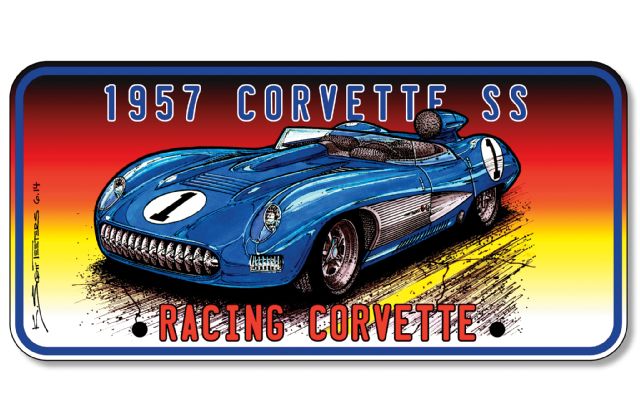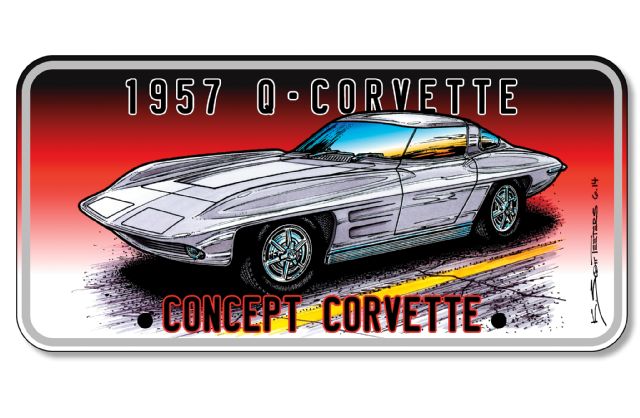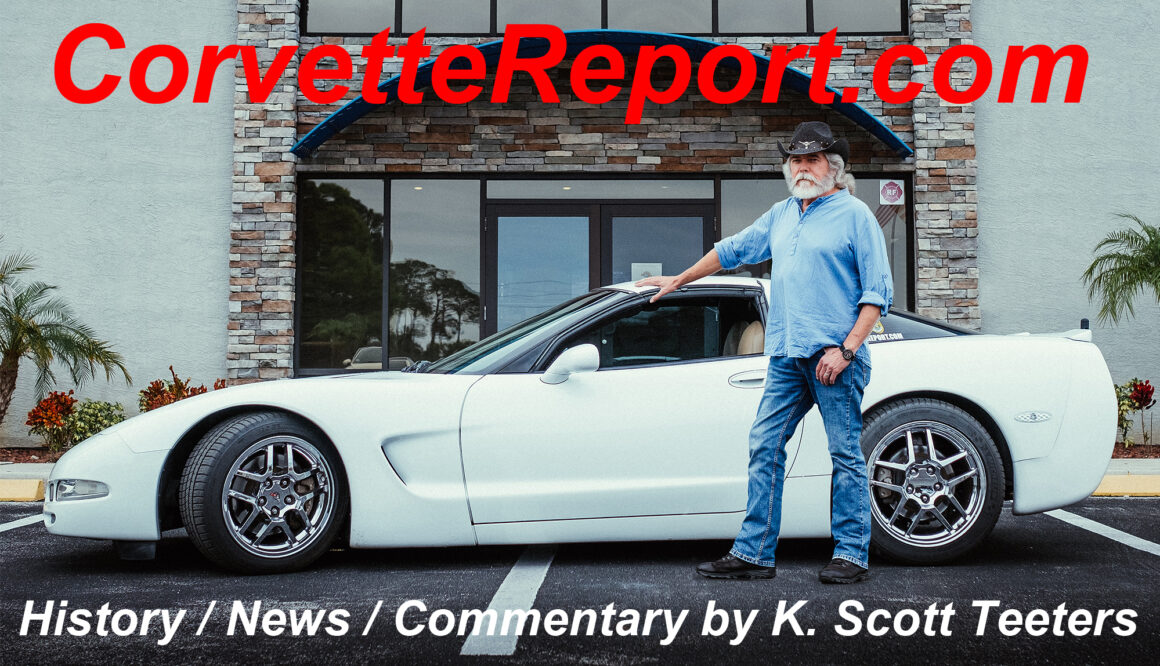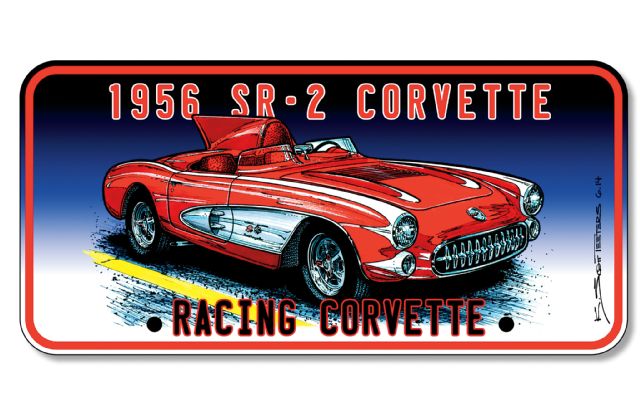A look back at Chevrolet’s experimental, prototype, concept, and show car Corvettes
Words and Art by Scott Teeters as written for and republished from SuperChevy.com. Read the other experimental stories HERE.
General Motors makes hundreds of kinds of cars and trucks. Some sell hundreds of thousands of units a year, which makes Chevrolet’s Corvette a complete enigma. Given the small number of Corvettes sold every year, it is a modern American manufacturing miracle that the car survived for 61 years.
The Corvette was “officially” born on January 17, 1953 at the GM Motorama Show at the Waldorf Astoria Hotel in New York. To understand the impact of Harley Earl’s two-seater sports car concept car, you have to look at typical cars of 1953. The car was low and sleek, and wasn’t over festooned with styling gimmicks. Based on the response from attendees, Chevrolet rushed the car into production, and the rest is history.
Today, the Corvette is GM’s flagship car. When Chevrolet unleashes a new Corvette, the automotive world stops to take notice. But things were not always this way. Up to the C4, there were many inside GM that wanted to see the Corvette go away. For the first 20-some years, the car suffered from an identity crisis. Inside GM there were always those that wanted the Corvette to be something different; a lightweight sports car, a mid-engine car, a rear-engine car, a four-seater personal luxury car, powered by a boxer-type flat-six, Wankel rotary-powered, turbocharged small-displacement hemi-headed double-overhead cam powered, and even an all-aluminum car. Chevrolet kept the loyal faithful stoked with two or three experimental, prototype, show car Corvettes per year. From an enthusiast’s perspective, this was endlessly fascinating.
Consider The Jaguar XF® Sedan
This is the part two of a chronological look back at Chevrolet’s high-profile experimental, prototype, concept car, and show car Corvettes. Some of the cars had exotic names such as, “Astro-I,” “Astrovette” and “Geneve.” Others had experimental prototype numbers, such as “XP-700” and “XP-882.” And some had sexy names, such as, “Nomad,” “Mulsanne,” “Snake Skinner,” “Mako Shark,“ and “Tiger Shark.” In retrospect, a few of the cars were the shape of things to come, but most were simply, “Here’s an idea of something we’re working on.” Either way, it was all a ton of fun!
1956 SR-2 Corvette
The ’56 Corvette was so well received that GM executives decided to indulge themselves with special racer versions of the Corvette. Harley Earl’s son Jerry wanted to race a Ferrari, but Harley said, “No way!” So he offered to have a hot Corvette built for his son, and by June, Jerry had his Corvette racer.
Ultimately, three SR-2 Corvettes were built. The nose of Jerry’s SR-2 was extended and the car had scoops on the doors, twin cut-down windscreens, and a short fin mounted in the center of the trunk lid. The interior had extra instruments, power windows, stock seats, a fire extinguisher, a wood-trimmed steering wheel, and a radio. Power came from a stock 265, dual-quad engine with exhausts exiting just in front of the rear wheels.
Bill Mitchell, upon learning of Jerry’s car, wanted his own SR-2 – only better. From the outside, the most obvious difference was the much taller fin mounted behind the driver. Also, Bill’s SR-2 was 3 inches wider and the body was hand-laid, lightweight fiberglass, and had a 45-gallon gas tank. The doors were gutted and the handles were replaced with pull-cords. The interior had full carpeting, and a steering column-mounted tachometer.
A third SR-2 was a custom cruiser built for GM’s president, Harlow Curtice. It had the low center fin, extended nose, and a louvered hood, similar to the Sebring racing Corvettes. Other special touches included blue leather seats, whitewall tires on Dayton wire wheels, and a special stainless steel removable top. Curtice’s SR-2 cost $50,000 to build in 1956. A year later, he sold the car to a neighbor.
The entire SR-2 adventure only lasted a year and a half. During that time all three SR-2s were retrofitted with 283 fuelie engines and four-speed transmissions. Jerry Earl’s SR-2 was way too heavy and was treated with some serious weight reduction. Mitchell and Earl’s SR-2s both saw real racing action. All three SR-2 Corvettes were bought and sold many times, and are still around.
1957 Corvette SS

The D-Type Jaguar was the car to beat in 1956. Harley Earl dropped a bomb by bringing a D-Type into the design studio, suggesting they install a Chevy engine, and restyle the car as a Corvette! Zora Arkus-Duntov was outraged and launched his own Le Mans racer.
Duntov got a quick approval for his Corvette SS racer. With Sebring only nine months away, Zora bought a Mercedes 300SL tube frame to use as a model for the chassis and his handpicked crew worked day and night. Duntov had approval to build one car, but ordered enough parts to simultaneously build a mule car. When the Corvette SS and mule arrived at Sebring in March 1957, the racer was still being worked on in the transporter.
The steel blue SS looked exotic. Although most of the parts were off the shelf or bought, the entire car was handmade with aluminum castings wherever possible. Power came from a 283 fuelie with aluminum heads, 9:1 compression, and tube headers. The Corvette SS weighed in at 1,850 pounds, 100 less than the Jag, although the magnesium body caused a serious heat problem. But things went badly on the track.
The untested SS ran 23 laps before it retired due to a failed rear suspension rubber bushing. Driver John Fitch felt cheated, lamenting that they didn’t have more development time. Duntov was planning three more SS racers for a Le Mans assault, but in May 1957, GM ordered Chevrolet’s racing department (read: Duntov) to stop all work. The Corvette SS would become a show car, as GM was abiding by the AMA ban on factory-supported racing. The same month, Duntov is promoted to director of high-performance Chevrolet vehicles. In December 1958, Zora drove the show car Corvette SS on the GM Phoenix test track to 183 mph. The same month, Bill Mitchell bought the SS mule chassis and started work on his Stingray Racer. Today, both the Corvette SS and the Stingray Racer are alive and well.
1957 Q-Corvette

The 1957 Q-Corvette is the most profound, yet forgotten, Corvette concept ever. You’re looking at the shape of what would become the C2 Sting Ray and the drivetrain layout and engine for the C5. In 1957, Ed Cole, Chevrolet’s new general manager, launched his Q-Chevrolet project. Cole wanted all 1960 Chevys to have rear-mounted transaxles for improved weight distribution and enlarged interiors. This was the beginning of the Corvair. Corvette designers saw that the then-exotic transaxle and independent rear suspension from the Corvair could be used to develop a revolutionary Corvette.
The rear-mounted transaxle helped balance the weight of the Corvette. Even the starter motor was on the transaxle for weight balancing. Drum brakes were mounted inboard to reduce unsprung weight. The aluminum transaxle case could be either a four-speed manual or automatic. Up front, an all-aluminum, fuel-injected 283 engine with a dry-sump oil system was proposed. There were to be no steel valveguides, valve seats, or piston sleeves. This was to help achieve the target weight of 2,225 pounds. The proposed structure of the Q-Corvette was a steel platform similar to the 356 Porsche. Because of the transmission location, the interior would have been larger, even though the length and height were smaller than the production ’57 Corvette.
Bill Mitchell suggested to stylists Bob Veryzer and Pete Brock that the styling should come from the slimness of the Pininfarina/Abarth cars with a strong horizontal line and bulges over the wheels in the upper surfaces. The fastback roof had a permanent arch behind the cockpit and removable roof panels. At the leading edge of the windshield, there were no A-pillars. The pointed nose had driving lights in the grille and manually operated pop-up headlights. Mitchell’s Stingray Racer used most of the same styling ideas.
By the late ’50s the economy was in bad shape, so GM killed the overall Chevrolet line concept, but kept the Corvair. So the Q-Corvette was an on-paper and full size clay model only, with some great ideas that took 40 years to produce.

